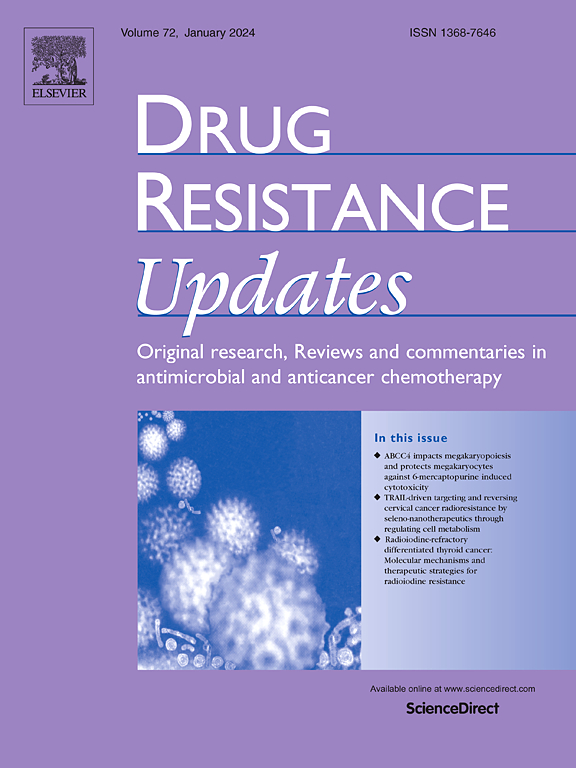RNF217-KEAP1-NRF2 feedback loop confers therapeutic resistance by inhibiting ferroptosis in esophageal squamous cell carcinoma
IF 21.7
1区 医学
Q1 PHARMACOLOGY & PHARMACY
引用次数: 0
Abstract
Resistance to chemoradiotherapy is a crucial factor limiting the efficacy of therapy and prognosis of esophageal cancer. It is necessary to elucidate the key genes and regulatory mechanisms responsible for therapeutic resistance in esophageal squamous cell carcinoma (ESCC). In this study, we found a relationship between ferroptosis and therapeutic sensitivity in ESCC and identified the ring finger protein 217 (RNF217) as a new regulator of ferroptosis associated with resistance to chemoradiotherapy in ESCC. Mechanistically, RNF217 interacts with kelch like ECH associated protein 1 (KEAP1) and promotes its ubiquitination and degradation, resulting in nuclear factor erythroid 2-related factor 2 (NRF2) evading KEAP1-mediated degradation and, consequently, enhanced NRF2 signaling and led to ferroptosis resistance. Furthermore, NRF2 facilitated the transcription of RNF217 by binding to antioxidant response elements in the RNF217 promoter upon irradiation. Overall, our findings indicate that the RNF217-KEAP1-NRF2 feedback loop is a previously unrecognized mechanism regulating resistance to chemoradiotherapy in ESCC and could be a target to overcome therapeutic resistance in ESCC.
RNF217-KEAP1-NRF2反馈回路通过抑制食管鳞状细胞癌的铁下垂赋予治疗抗性
放化疗耐药是制约食管癌治疗效果和预后的重要因素。阐明食管鳞状细胞癌(ESCC)耐药的关键基因及其调控机制是十分必要的。在这项研究中,我们发现了ESCC中铁下沉与治疗敏感性之间的关系,并确定了环指蛋白217 (RNF217)是ESCC中与放化疗耐药相关的铁下沉的新调节因子。机制上,RNF217与kelch样ECH相关蛋白1 (KEAP1)相互作用,促进其泛素化和降解,导致核因子红系2相关因子2 (NRF2)逃避KEAP1介导的降解,从而增强NRF2信号传导,导致铁沉抗性。此外,NRF2通过与RNF217启动子中的抗氧化反应元件结合,促进了RNF217的转录。总之,我们的研究结果表明,RNF217-KEAP1-NRF2反馈回路是一种以前未被认识到的调节ESCC放化疗耐药的机制,可能是克服ESCC治疗耐药的靶点。
本文章由计算机程序翻译,如有差异,请以英文原文为准。
求助全文
约1分钟内获得全文
求助全文
来源期刊

Drug Resistance Updates
医学-药学
CiteScore
26.20
自引率
11.90%
发文量
32
审稿时长
29 days
期刊介绍:
Drug Resistance Updates serves as a platform for publishing original research, commentary, and expert reviews on significant advancements in drug resistance related to infectious diseases and cancer. It encompasses diverse disciplines such as molecular biology, biochemistry, cell biology, pharmacology, microbiology, preclinical therapeutics, oncology, and clinical medicine. The journal addresses both basic research and clinical aspects of drug resistance, providing insights into novel drugs and strategies to overcome resistance. Original research articles are welcomed, and review articles are authored by leaders in the field by invitation.
Articles are written by leaders in the field, in response to an invitation from the Editors, and are peer-reviewed prior to publication. Articles are clear, readable, and up-to-date, suitable for a multidisciplinary readership and include schematic diagrams and other illustrations conveying the major points of the article. The goal is to highlight recent areas of growth and put them in perspective.
*Expert reviews in clinical and basic drug resistance research in oncology and infectious disease
*Describes emerging technologies and therapies, particularly those that overcome drug resistance
*Emphasises common themes in microbial and cancer research
 求助内容:
求助内容: 应助结果提醒方式:
应助结果提醒方式:


